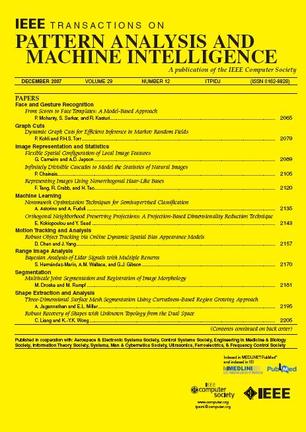Learning Canonical Embeddings for Unsupervised Shape Correspondence with Locally Linear Transformations
IF 20.8
1区 计算机科学
Q1 COMPUTER SCIENCE, ARTIFICIAL INTELLIGENCE
IEEE Transactions on Pattern Analysis and Machine Intelligence
Pub Date : 2022-09-05
DOI:10.48550/arXiv.2209.02152
引用次数: 0
Abstract
We present a new approach to unsupervised shape correspondence learning between pairs of point clouds. We make the first attempt to adapt the classical locally linear embedding algorithm (LLE)-originally designed for nonlinear dimensionality reduction-for shape correspondence. The key idea is to find dense correspondences between shapes by first obtaining high-dimensional neighborhood-preserving embeddings of low-dimensional point clouds and subsequently aligning the source and target embeddings using locally linear transformations. We demonstrate that learning the embedding using a new LLE-inspired point cloud reconstruction objective results in accurate shape correspondences. More specifically, the approach comprises an end-to-end learnable framework of extracting high-dimensional neighborhood-preserving embeddings, estimating locally linear transformations in the embedding space, and reconstructing shapes via divergence measure-based alignment of probability density functions built over reconstructed and target shapes. Our approach enforces embeddings of shapes in correspondence to lie in the same universal/canonical embedding space, which eventually helps regularize the learning process and leads to a simple nearest neighbors approach between shape embeddings for finding reliable correspondences. Comprehensive experiments show that the new method makes noticeable improvements over state-of-the-art approaches on standard shape correspondence benchmark datasets covering both human and nonhuman shapes.具有局部线性变换的无监督形状对应的学习规范嵌入
我们提出了一种在点云对之间进行无监督形状对应学习的新方法。我们首次尝试采用经典的局部线性嵌入算法(LLE),该算法最初是为形状对应的非线性降维而设计的。关键思想是通过首先获得低维点云的高维邻域保持嵌入,然后使用局部线性变换对齐源嵌入和目标嵌入,来找到形状之间的密集对应关系。我们证明,使用新的LLE启发的点云重建目标学习嵌入可以产生精确的形状对应。更具体地说,该方法包括一个端到端的可学习框架,用于提取高维邻域保持嵌入,估计嵌入空间中的局部线性变换,以及通过在重建形状和目标形状上建立的概率密度函数的基于散度测度的对齐来重建形状。我们的方法强制形状在对应关系中的嵌入位于相同的通用/规范嵌入空间中,这最终有助于规范学习过程,并导致形状嵌入之间的简单近邻方法,以找到可靠的对应关系。综合实验表明,在覆盖人类和非人类形状的标准形状对应基准数据集上,新方法比最先进的方法有了显著的改进。
本文章由计算机程序翻译,如有差异,请以英文原文为准。
求助全文
约1分钟内获得全文
求助全文
来源期刊
CiteScore
28.40
自引率
3.00%
发文量
885
审稿时长
8.5 months
期刊介绍:
The IEEE Transactions on Pattern Analysis and Machine Intelligence publishes articles on all traditional areas of computer vision and image understanding, all traditional areas of pattern analysis and recognition, and selected areas of machine intelligence, with a particular emphasis on machine learning for pattern analysis. Areas such as techniques for visual search, document and handwriting analysis, medical image analysis, video and image sequence analysis, content-based retrieval of image and video, face and gesture recognition and relevant specialized hardware and/or software architectures are also covered.

 求助内容:
求助内容: 应助结果提醒方式:
应助结果提醒方式:


